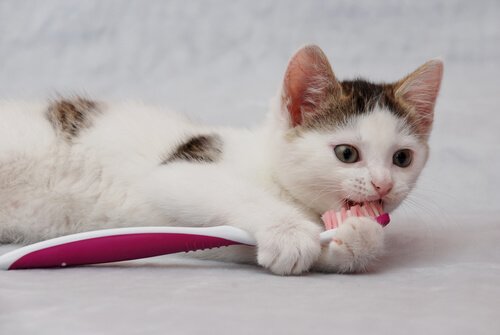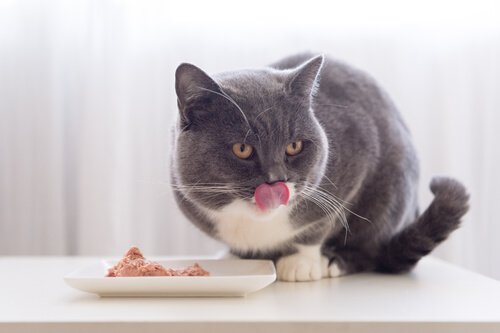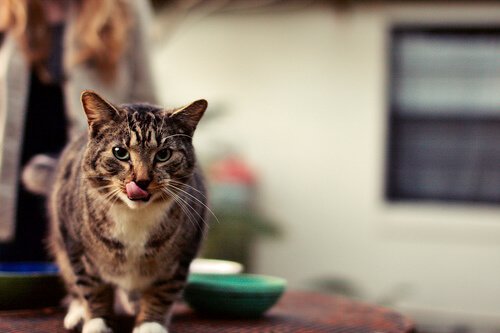How to Maintain Your Cat's Oral Hygiene

The diagnoses for dental diseases in domestic cats are on the rise. These are almost always painful and uncomfortable for your pet. That’s why its’ so important to take care of your cat’s oral hygiene. It’s the best way to prevent problems and maintain their health.
The importance of your cat’s oral hygiene
Oral hygiene is a basic part of overall health, no matter what species you’re dealing with. Cats need oral care to make sure their digestive functions work properly and to keep too many microorganisms from growing. Oral and dental diseases are usually a result of plaque building up in the teeth and gums. Bad breath is the first sign of your cat having an oral hygiene problem.
Those kinds of problems almost always come from poor or nonexistent oral hygiene. Daily brushing is the only way to get rid of plaque and to keep tartar from building up. It’s worth repeating: your cat’s oral hygiene is absolutely import for his health.
Plaque and tartar: what they are and why you need to fight them
Cats tend to get food particles stuck between their teeth and gums . These parts of their mouth are perfect for all kinds of bacteria to grow at an extremely fast rate.

This bacteria, combined with the sugar molecules in their food, is what cause plaque to form. Plaque is a tiny, colorless, sticky particle that glues itself onto the teeth and gums. This leads to a cycle where the plaque becomes a food for the bacteria. It produces toxins and acids that irritate the gums and wear away tooth enamel.
If you don’t get rid of the plaque soon enough, it combines with the minerals in your cat’s saliva and hardens. Tartar (also known as calculus), is the outcome when it hardens. Once the tartar has formed, bacteria glues itself to the teeth and devours the tooth enamel, which is what causes cavities.
How to get rid of the tartar in your cat’s mouth
Once plaque has hardened into tartar, using a traditional brush won’t be enough. At that point you’ll have to take your cat to a vet who specializes in feline dentistry to perform a surgery (with anesthesia). What kind of surgery, how intense it is, and how long it will take your cat to recover all depends on how bad the tartar build-up is.
We can’t emphasize enough how important prevention is when it comes to your cat’s oral hygiene. There are simple ways to maintain your cat’s oral hygiene and keep them from going through pain and complicated treatments.
A balanced diet: essential for your cat’s oral hygiene
An unbalanced diet can cause a lot of health problems from bad breath, obesity, digestive issues, and even diabetes. Choosing a balanced diet for your cat has a lot to do with its age and size. There are also commercial cat foods for things like allergies, obesity, and urinary, renal, or liver-related issues.

There are currently some innovative foods that can stop plaque from forming by using a combination of mechanical abrasion and chemical substances. Even with these foods, you still need to brush your cat’s teeth on a daily basis.
Oral hygiene: tips to make brushing your cat’s teeth easier
1. Start when they’re young
The same goes for humans: cats have to get into the habit of getting their teeth brushed on a daily basis. It’s always best to start as soon as possible, during their first few weeks of life.
2. Using products made for cats
Human toothpastes can damage your cat’s tooth enamel and poison them. There are pastes and brushes made for cats of all ages. A lot of animal toothpastes have nice flavors and smells, like beef or chicken.
3. Make tooth-brushing a positive experience
It’s only natural that your cat will be stressed out and uncomfortable when you brush his teeth. Therefore, try to do your best to make brushing your cat’s teeth a less intense experience. One great way to distract them is to make it seem like a game. Start by touching his mouth and teeth. Once he feels comfortable, you can use the toothbrush by brushing his teeth gently.
4. Carefully brush their teeth and gums
You should always be brushing carefully and completely, cleaning both his gums and teeth. You have to be especially gentle with your cat’s gums to prevent bleeding. Make sure you brush every corner of his mouth. You also need to remember to brush up and down, and left and right. It can also be good to add some small, circular motions.
